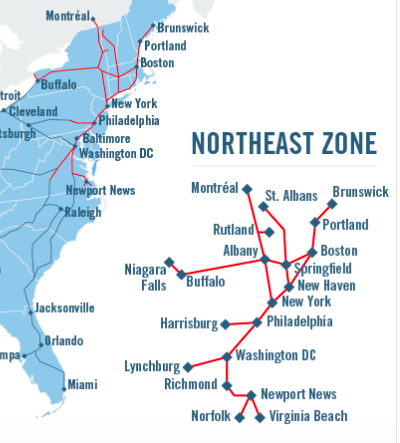Because the Northeast is such a heavily trafficked area, and there’s a large presence of commuters, redeeming miles and points can be a great value.
There’s three major ways to get up and down the Northeast corridor – that is, the stretch between Washington DC, Philadelphia, New York and Boston – driving (which can take hours on end depending on traffic), flying, or taking the train.
I won’t talk about driving here because not only do I think it is inconvenient, but in many cases, it can be more expensive that flying or taking the train when you start to account for gas, tolls and parking. Most people think they’re saving money this way, but in reality, they’re not.
Flying
Flying can be convenient to get up the coast fast, however the Northeast is known as being a delay-prone area, whether it comes to winter storms or heavy air traffic. You’ll be flying into and out of some of the busiest airports in the country, so don’t assume you’ll get there right on the dot or early.
- Washington Dulles is primarily used for international flights, and as United hub. This is not the most convenient airport for accessing Washington DC as it is set well outside the city, and transport to the downtown area can be expensive.
- Washington Reagan airport is located just north of Alexandria, VA, right on the Metro line, with convenient access to downtown. Reagan is notoriously busy during commuter hours, so expect long lines and delays.
- Philadelphia is primarily American hub, with somewhat convenient access to the inner city via the SEPTA service. Philadelphia is sometimes the forgotten step-child of the Northeast, though can be strategic depending on where you are flying to.
- New York La Guardia is the closest airport to Manhattan, though is plagued by delays, long lines, and older facilities.
- JFK is the primary international airport for New York, however I find it more convenient than La Guardia to get into NYC, since you can take the Air Train to Jamaica and then transfer on the Long Island Railroad.
- Newark is well, Newark. Newark tends to have cheaper flights, and is located directly along an Amtrak/New Jersey Transit route.
- Boston Logan is somewhat convenient to downtown, though can be horrendous in the winter months.
You’ll find near hourly service between Boston, La Guardia and Washington Reagan, both on the former US Airways shuttle, and the Delta Shuttle.
Because all of these cities are within 650 miles of each-other, you’re best use of miles to get from A to B is using British Airways Avios. You’ll spend 4,500 Avios and $5 in taxes for any flights between the above cities, which is a heck of a deal.
You can transfer American Express Membership Rewards, Chase Ultimate Rewards or Starwood Preferred Guest Starpoints to British Airways Avios.
The Train
Taking the train was once seen as an old-school method of transportation, but has picked up in recent years. To get all the way from Washington DC to Boston, you’ll need to utilize Amtrak, though it’s possible to get to intermediate stations via local services such as the New Jersey transit, SEPTA, etc. For the purposes of this post, I’ll just talk about Amtrak.
- Washington Union station is located near the capitol, and because it is a terminus, trains tend to run on time.
- Philadelphia’s 30th street station is in the western portion of the city, though is convenient to major attractions by taking the SEPTA train 1-3 stops, which is free with an Amtrak boarding pass.
- New York’s Penn Station is located adjacent to Madison Square Garden. Convenient to Time Square and Fifth Avenue, Penn Station can be a mad-house, so be sure to arrive with plenty of time.
- Boston’s South Station is one of several stations in the city, so be sure to look at the Amtrak schedule for other stops that may be convenient to neighboring attractions.
Amtrak has convenient hourly departures going north and south, and offers two types of services: an Acela, faster service, or a Regional, slower, and makes more stops, service. From end to end, it’s pretty much an all day journey, however you’re able to work while speeding along the rails thanks to onboard wifi.
What separates the train from flying is convenient departures from downtown stations, avoiding the need to take a taxi or commuter train just to get to the airport. You’ll also find intermediate station stops, in case you need to get to Wilmington, DE, for example, and not Philadelphia.
Redeeming points between any Northeast city is easy – it’s just 4,000 Amtrak Guest Rewards points, which can be transferred in from Chase Ultimate Rewards, if you’d like. Fares in the Northeast can run easily into the $200s, so using points is an excellent way to save money. Using Amtrak points allows you to get a seat on the train, so long as there is a seat for sale, so there’s no award inventory to grapple with, which is nice (though there are blackout dates). Check out my post on Amtrak sweet spots here, if you’re interested.
There’s a neat trick to always guarantee your Amtrak ticket is always under $50, if you don’t have the points yet, too.
Sum it Up
Flying will cost you 4,500 miles and $5, if you can use British Airways Avios. Otherwise, you’ll be forced to pay a higher fare with, United miles, let’s say. Taking the train costs you 4,000 Amtrak points, and no taxes. In the end, both come in pretty equally, though it’s up to you to decide on what’s important to you.
- Is working and speaking on the phone important? Take the train.
- Is speed important? Fly.
- Is lounge access important? Both have lounges at major cities.
- Are you connecting onto another flight? Fly.
- Have a downtown meeting, or heading to a downtown hotel? Take the train





 Jamie Larounis is an avid traveler, blogger and miles/points educator. Traveling well over 100,000 miles a year and staying in hotels for over 100 nights, he leverages miles, points and other deals to fly in first class cabins, and stay in 5-star hotels. The Forward Cabin shares his experiences, musings, reviews, tips, tricks, resources and industry news with you, the fellow traveler.
Jamie Larounis is an avid traveler, blogger and miles/points educator. Traveling well over 100,000 miles a year and staying in hotels for over 100 nights, he leverages miles, points and other deals to fly in first class cabins, and stay in 5-star hotels. The Forward Cabin shares his experiences, musings, reviews, tips, tricks, resources and industry news with you, the fellow traveler.
I am from Scotland and am a member of the BA Executive Club. What is the procedure for me to use Avios for flights from, say, Boston to Washington? Do I need to have a frequent flier membership of the relevant carrier?
No. Just use your Avios that you already have to purchase the flight on BA.com.
Thanks, James